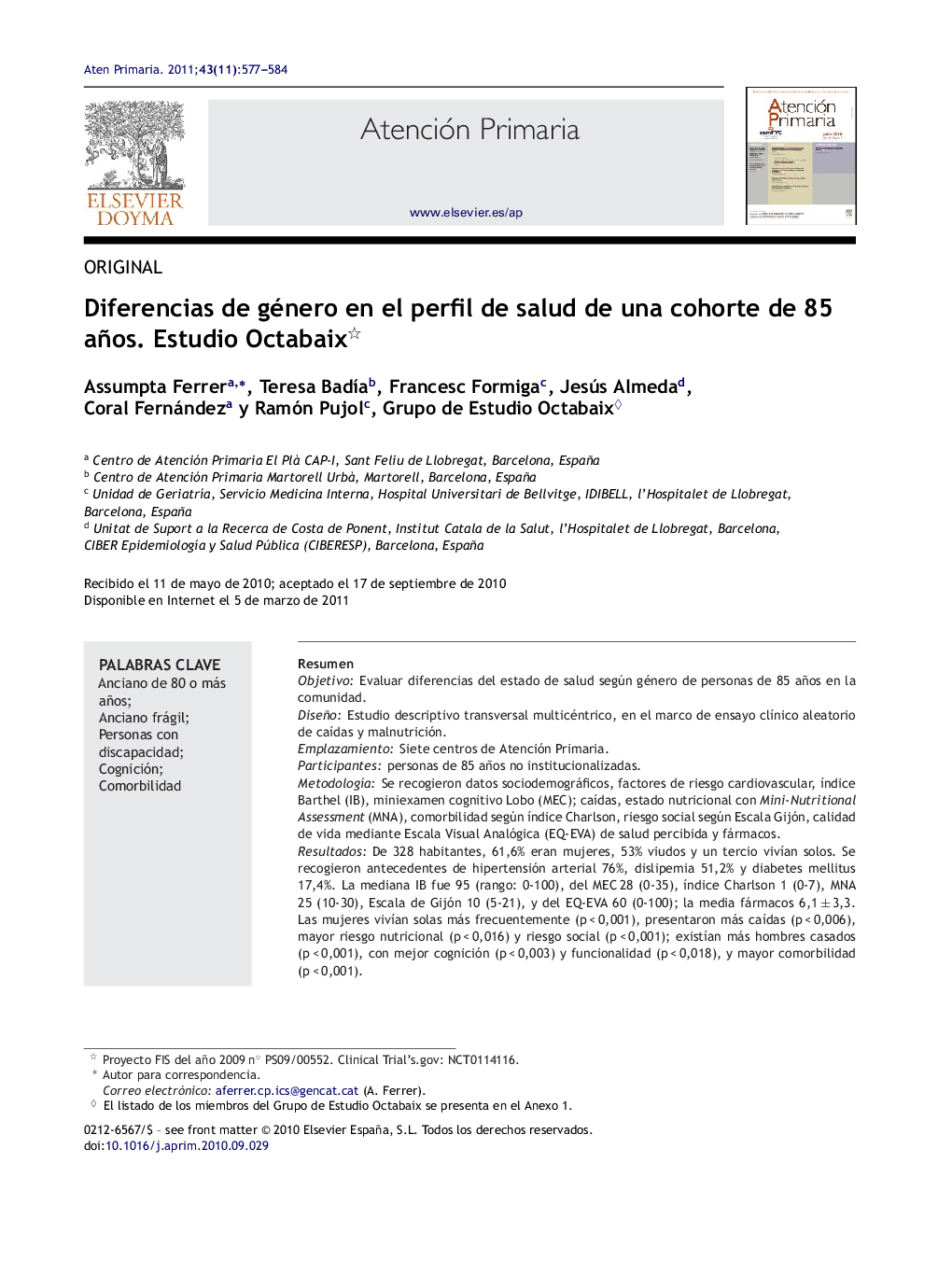| Article ID | Journal | Published Year | Pages | File Type |
|---|---|---|---|---|
| 3457193 | Atención Primaria | 2011 | 8 Pages |
ResumenObjetivoEvaluar diferencias del estado de salud según género de personas de 85 años en la comunidad.DiseñoEstudio descriptivo transversal multicéntrico, en el marco de ensayo clínico aleatorio de caídas y malnutrición.EmplazamientoSiete centros de Atención Primaria.Participantespersonas de 85 años no institucionalizadas.MetodologíaSe recogieron datos sociodemográficos, factores de riesgo cardiovascular, índice Barthel (IB), miniexamen cognitivo Lobo (MEC); caídas, estado nutricional con Mini-Nutritional Assessment (MNA), comorbilidad según índice Charlson, riesgo social según Escala Gijón, calidad de vida mediante Escala Visual Analógica (EQ-EVA) de salud percibida y fármacos.ResultadosDe 328 habitantes, 61,6% eran mujeres, 53% viudos y un tercio vivían solos. Se recogieron antecedentes de hipertensión arterial 76%, dislipemia 51,2% y diabetes mellitus 17,4%. La mediana IB fue 95 (rango: 0-100), del MEC 28 (0-35), índice Charlson 1 (0-7), MNA 25 (10-30), Escala de Gijón 10 (5-21), y del EQ-EVA 60 (0-100); la media fármacos 6,1 ± 3,3. Las mujeres vivían solas más frecuentemente (p < 0,001), presentaron más caídas (p < 0,006), mayor riesgo nutricional (p < 0,016) y riesgo social (p < 0,001); existían más hombres casados (p < 0,001), con mejor cognición (p < 0,003) y funcionalidad (p < 0,018), y mayor comorbilidad (p < 0,001).ConclusionesSer hombre a los 85 años se asocia a estar casado, tener mejor funcionalidad y cognición, y mayor comorbilidad, mientras que ser mujer se asocia a vivir sola, con mayor índice de caídas, de riesgo nutricional y de riesgo social, lo que debería tenerse en cuenta para contribuir a que estas personas más mayores puedan mantener su espacio en la comunidad.
ObjectiveTo examine gender differences according to health status in the oldest old people of the community.DesignCross-sectional multicentre study, within the framework of a clinical trial on falls and malnutrition.Setting7 primary health centres.ParticipantsNon-institutionalised patients of 85 years or over.MethodsThe data collected included, socioeconomic data, cardiovascular risk factors, Barthel Index (BI), cognitive status with the Mini-Mental State Examination (MMSE), Charlson Index to measure comorbidity, nutritional risk evaluated by Nutritional Assessment questionnaire (MNA), mean visual analogue self-rating scale in Euroqol- 5D (EQ-VAS) to assess health related quality life and, Gijón social risk test, and prescribed drugs.ResultsA total of 312 subjects were included, of which 61.6% were women, 53% widows and a third of them lived alone. High blood pressure was observed in 76%, dyslipidemia in 51.2%, diabetes in 17.4%, median BI 95 (rank 0-100), MMSE 28 (0-35), Charlson index 1 (0-7), MNA 25 (10-30), Gijón test 10 (5-21), EQ-VAS 60 (0-100) and the mean prescription drugs 6.1 ± 3.3. Women most frequently lived alone (P < .001), fell more (P < .006), had a greater nutritional (P < .016) and social risk (P < .001). Men were more likely to be married (P < .001), had better cognition (P < .003), better functional status (P < .018), and higher comorbidity (P < .001).ConclusionBeing a 85 years old man is associated with being married, having better functionality and cognition, and a higher comorbidity. While being a woman is associated with living alone, a higher rate of falls, and nutritional and social risk. These results are important to help this group of elderly to maintain their position in the community.
